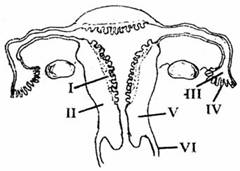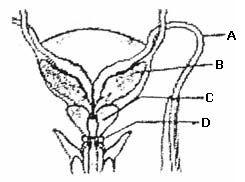The hemoglobin of a human foetus:
|
What happens during fertilisation in humans after many sperms reach close to the ovum? |
Answer | ||||||||||||||||||||||||||||
|
Column I contains terms and column II contains definitions. Match them correctly and choose the right answer.
|
Answer | ||||||||||||||||||||||||||||
|
Ovulation in the human female normally takes place during the menstrual cycle |
Answer | ||||||||||||||||||||||||||||
|
The figure given below depicts a diagrammatic sectional view of the female reproductive system of humans.Which one set of three parts out of I – VI have been correctly identified? |
Answer | ||||||||||||||||||||||||||||
|
Given below is a diagrammatic sketch of a portion of human male reproductive system. Select the correct set of the names of the parts labelled A, B, C, D.
|
Answer | ||||||||||||||||||||||||||||
|
The Leydig cells as found in the human body are the secretory source of |
Answer | ||||||||||||||||||||||||||||
|
In a normal pregnant woman, the amount of total gonadotropin activity was assessed. The result expected was |
Answer | ||||||||||||||||||||||||||||
|
Signals for parturition originate from |
Answer | ||||||||||||||||||||||||||||
|
Which one of the following statements is false in respect of viability of mammalian sperm? |
Answer | ||||||||||||||||||||||||||||
|
The endocrine structure and the corresponding hormones are listed in the table below. Match the columns and select the correct option.
|
Answer |


